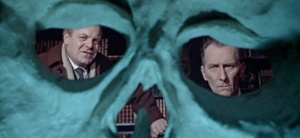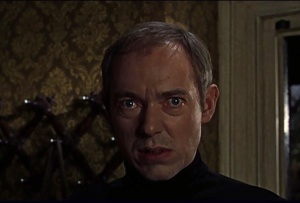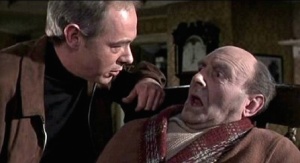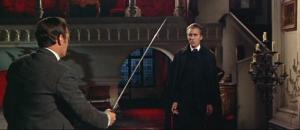By Wheeler Winston Dixon.
It’s Halloween once again, and as one might suspect, American cable networks are offering a cornucopia of horror films, past and present, though the Universal films of the 1930s and 40s which started the entire horror cycle in America are now missing from most playlists. Val Lewton’s superb RKO gothics got better treatment from Turner Classic Movies, which ran a whole stack of them this year, and the British films produced by Hammer and Amicus in the 1960s were also well represented on the channel, albeit run at two and three in the morning, not exactly peak viewing hours.
The Hammer films, once “X”-rated in Britain upon their initial release, now seem like quaint fairy tales, which is what Hammer director Terence Fisher always claimed they were – “fairy tales for adults.” These are films I know well, have seen many times, and have written about on numerous occasions. I no longer watch them all the way through; instead, I dip into them, keying in on certain scenes that I admire, and then switching to another film with much the same purpose in mind.
But as I sampled one Hammer and/or Amicus film after another in this fashion in the past few days, something hit me more forcefully than it ever has before in this particular subset of films – the use of silence, and a lack of dialogue, is a trait that nearly all of these films share. The most effective of these films operate through the power of the image alone, in concert with the movements of the actors, and the music of Elisabeth Lutyens and James Bernard, the two most accomplished composers who worked on the Hammer and Amicus films.
The title of this essay comes from Terence Fisher’s 1964 science fiction horror film The Earth Dies Screaming, which actually wasn’t a Hammer or Amicus film at all, but rather a British co-production between Robert Lippert and Twentieth Century Fox. Shot quickly and cheaply in black and white by the gifted Arthur Lavis, the film documents the aftereffects of a worldwide “gas attack” of unknown origin, which has killed off the world’s entire population except for a few fortunate souls in oxygen tents, ventilated rooms, or other protected environments.
As the film opens, we see a train crash after the engineer and his assistant fall dead, a car smash into a wall, an airplane make a fatal plunge into a wooded grove, and various citizens, from white collar commuters in bowler hats, to factory employees punching in at their time clocks, drop dead in their tracks. The camera pans down to a young woman, obviously dead, sprawled in front of the camera in a verdant meadow, as the main titles come up, seeming to drift out of the sky. We’re about three minutes in, and not a word has been spoken.
Fisher cuts to the figure of Jeff Nolan (Willard Parker), grimly driving a jeep through this landscape of decimation. As the sequence continues, he surveys groups of dead bodies, raids an electronic store to pick up a shortwave radio set, and continues on to a small village inn, where he parks the jeep and walks inside. Setting up the radio on the bar, he scans the dial in search of some sort of signal, but receives only a droning whine on every frequency. He tries the inn’s television set, with the same result; nothing but static and the same droning sound on every channel.
Then suddenly, we hear a voice off screen, commanding Nolan to “turn it off!” As he turns around, Nolan is confronted by the sight of Quinn Taggart (Dennis Price) holding a revolver on him, accompanied by his unwilling companion Peggy (Virginia Field). The narrative then kicks in with a rather conventional exposition sequence, but despite this, it’s remarkable to note than in a 62 minute film, the first five to six minutes have conveyed Fisher’s vision of the end of civilization entirely through a dispassionate series of images, with Lutyens’ music as occasional accompaniment.
Furthermore, one of the central plot pegs in The Earth Dies Screaming is the eventual reanimation of the recently deceased as part of an alien plan of attack, prefiguring George Romero’s Night of the Living Dead (1968) by a number of years. Needless to say, once these reanimated “zombies” are roaming the land for victims, they have no dialogue at all – simply a desire for human flesh, in keeping with the dictates of the genre. Thus, much of the film, involving the pursuit of the living by the dead, is done entirely through gesture, and the baleful gaze afforded by the “dead eyes” of the newly minted “undead.”
This use of image, natural sound and sparse musical backing occurs and reoccurs in British cinema of the 1960s, as in Antonioni’s Blow-Up (1966) – especially the scenes in the park, and the remarkable sequence in which Thomas (David Hemmings), a London fashion photographer, “blows up” an image of a murder scene in a nearly fifteen minute segment that uses natural sound alone. But Blow-Up is something of an outlier in the cinema of the era, and obviously incorporates strategies that Antonioni had been using throughout his earlier career in the Italian cinema, as in L’Avventura (1960).
The British Gothic cinema, on the other hand, seems to have embraced this as a central strategy to lull the audience into a state of suspension of disbelief, and to remove any distractions that might interfere with their concentration on the image above all else. The most famous example of this is undoubtedly the final reel of Freddie Francis’s The Skull (1965), produced by Amicus, which has absolutely no dialogue for the final ten minutes of the film, as the malevolent power of the skull of the Marquis de Sade brings about the death of paranormal investigator Christopher Maitland (Peter Cushing) in a tastefully savage fashion.
As the skull literally explodes from the cabinet in which it has been locked, and even secured with a cross, and candles in Maitland’s study ignite themselves as part of some unholy ceremony, the pictures on the walls of Maitland’s house begin to revolve crazily, conventional lighting gives way to an eerie palette of greens, purples and reds, and the skull floats dreamily through the hallways of Maitland’s mansion, able to penetrate doors, walls, and eventually flesh, in search of its next victim. Then, too, much of the film is photographed from the skull’s point of view, imbuing the skull with additional imagistic presence.
Yet this sequence, which has often been celebrated by such critics as David Pirie in his superb study of the genre, A Heritage of Horror: The English Gothic Cinema, is just one of many in the film that are entirely wordless, such as the scene in which Maitland is summarily arrested by two taciturn detectives, forced into a car, and then thrown into a surreal, minimalist courtroom and forced to play Russian Roulette by a hanging judge (Frank Forsyth), not once, but three times – again, all without a word of dialogue.
Other scenes, involving the initial exhumation of the skull at the film’s beginning by Pierre (Maurice Good), a grasping phrenologist, from de Sade’s grave; or the numerous sequences in which the shady antiques dealer Anthony Marco (Patrick Wymark) plots the sale of the skull to Maitland in his rundown bedsit; or the demise of Bert Travers, Marco’s seedy landlord (Peter Woodthorpe), as he plunges through a series of ornate stained glass windows to his death, are similarly stripped of nearly every bit of dialogue.
Francis, who won two Academy Awards for his cinematography, and who seemed unstoppable as both a cinematographer and a director in the 1960s, his most prolific era, never really stopped to consider why he structured the film this way – I interviewed him on numerous occasions from 1984 up until his death in 2007 – it just made sense to him to foreground the image above everything else, and let the visuals carry the entire weight of the narrative.
Francis used a similar strategy in his rather underrated film Torture Garden (1967), a “portmanteau” or “anthology” film comprised of four stories and a framing narrative in the manner of the classic horror film Dead of Night (1945), produced by Amicus’s Max J. Rosenberg and Milton Subotsky – a format the duo favored, and that served them well into the 1970s, though with distinctly diminishing returns. Indeed, with Torture Garden, perhaps the last of their truly accomplished horror films, the formula is beginning to fray at the edges, but in many ways, it’s a remarkable piece of work.
At a rundown sideshow, a sinister huckster aptly named Dr. Diabolo (Burgess Meredith) promises several people that he will give them a glimpse into their future if they will agree to gaze “deeply, deeply, deeply, into the shears of fate” held by the female deity Atropos (the iconic Clytie Jessop, who appears in several of Francis’s horror films, most notably Nightmare [1964], and never has one line of dialogue in any of them, using her unsettling visage as the sole method of performance).
The most effective of these segments, to my mind, is “Enoch,” based on a short story by Robert Bloch (who scripted many of Francis’s films), the author, of course, of the novel Psycho (1959), on which Alfred Hitchcock’s 1960 film is based. In “Enoch,” – though, somewhat confusingly, the central character is renamed “Balthazar” in the film – ne’er do well “bad penny” Colin Williams (Michael Bryant) conveniently turns up at his uncle Roger’s (Maurice Denham) country estate, where Roger has been living in seclusion for decades, with no visible means of support, but apparently blessed with great wealth.
Uncle Roger is dying, yet Colin has no sympathy for him. After a markedly artificial exchange of pleasantries, Colin comes straight to the point; since Uncle Roger is dying, he’ll have no need of his money. Colin demands to know where Roger’s fortune is hidden away, and in a deeply cruel sequence, withholds his Uncle’s heart medication in the hopes that he’ll finally divulge the source of his wealth, but to no avail. With a final seizure, Uncle Roger dies at Colin’s feet. Staring dispassionately at his uncle’s corpse, Colin mutters just one word: “Damn.”
Summoning the police, Colin is able to pass off his uncle’s death as a heart attack from natural causes – even his uncle’s personal physician, Dr. Silversmith (Niall MacGinnis) is deceived. Now, Colin has the house all to himself, without any interference from outsiders. Silversmith seems surprised that Colin is willing to spend the night in the house alone so soon after his uncle’s passing, but this is just what Colin has been angling for.
What follows, in a series of straight cuts that nevertheless convey a dreamlike sensibility suggesting an absence of linear time, is a bravura series of wordless scenes in which Colin tears the ancient house to pieces, knocking precious books off their shelves, smashing furniture, emptying closets and dresser drawers, all in a vain search for his uncle’s treasure. In his uncle’s bedroom, Francis cuts to an extremely low angle, just inches from the floor under the bed, showing that there’s a trap door to a cellar hidden beneath the room. During this entire time, not a word is spoken.
Despite the fact that we’re given this information as the audience, Francis lets Colin take his time making the same discovery, and it’s only when he pulls the mattress off his uncle’s bed that he finally sees the trap door, as Francis’s rack focuses through the bedsprings to show the bolted entryway on the floor. Pushing aside the bedframe in a frenzy, Colin opens the door with some difficulty, and descends to the basement, which seems to contain only a dirt floor, and one shovel, propped against the wall.
There’s absolutely nothing remarkable about the room, but for some reason, Colin seems to think that beneath the dirt floor, he may find the source of his uncle’s wealth. Grabbing the shovel, Colin begins to dig, and with another straight cut – not a dissolve – suddenly the floor has been entirely excavated, and the room strewn with dirt. There is something buried there, after all; a coffin, which Colin unhesitatingly pries open, to reveal a living cat, apparently buried alive but none the worse for the wear, and a headless skeleton.
The cat scampers up the stairs to freedom, and Colin regards the headless skeleton with disgust and revulsion, throwing the shovel into the pit, and walking back upstairs to collapse on the couch from exhaustion. But it’s here that the main plot device kicks in; the seemingly innocuous cat is actually a demon, Balthazar, who promises Colin – in a scene in which the cat seems to telepathically communicate with him – enormous wealth, if only he will do Balthazar’s bidding.
This is the first dialogue in at least ten minutes, once again, and it’s done as a “thought” voiceover, conveyed in just a few lines of dialogue, as Elisabeth Lutyens’ sinuous music ominously underscores Balthazar’s demands. And what, precisely, does Balthazar want? The demon wants nothing less than the wanton murder of everyone Colin can possibly kill, starting with a tramp (Barry Low) who has taken shelter in a shed next to the house for the night. Colin, his will no longer his own, stabs the tramp to death with a pitchfork, in a surprisingly violent sequence.
Another straight cut. Colin awakes on the sofa with a start, and blurts out one word – “dream” – in a questioning tone, as if perhaps none of this has happened. But, looking up from the sofa, he sees that the house is a wreck, and the trap door to the basement is ajar. As if in a trance, Colin walks down the stairs to the basement, where Balthazar is waiting for him. Again, through the power of his gaze, the cat “orders” Colin to dig anew in the cellar floor, which Colin does, unearthing a chest full of gold coins.
But, predictably, Balthazar isn’t satisfied with just one sacrifice; soon he orders Colin to kill the day nurse (Catherine Parker) who has been attending his uncle, when she reports for work the next morning. Colin again tries to resist, but can’t, and kills her, stuffing the body into a trunk. However, this time, he’s caught by the police trying to dispose of the body, and taken to jail. Naturally, no one believes his story, and then Balthazar mysteriously appears in Colin’s cell. The warder hears a horrific scream, and rushes to Colin’s aid, only to find his body on the floor of the cell, without a head.
As the police and Dr. Silversmith dispose of Colin’s decapitated body, Balthazar is nowhere to be found. But once the medical team has departed, and the desk sergeant (Norman Claridge) is seated at his desk in the otherwise deserted, rural police station, Balthazar reappears, staring fixedly at the startled official – who will be his next slave.
All in all, the sequence runs about twenty minutes, and contains less than ten lines of dialogue, other than the opening parry and thrust between Colin and Uncle Roger. With his uncle’s death and the appearance of Balthazar, aside from a few “thought communications” delivered in hushed voice over, and some desultory throwaway lines at the police station during the segment’s conclusion, “Enoch” becomes an almost wordless, utterly spellbinding narrative that depends entirely on the power of the visuals to convey the narrative – that, and the unsettling gaze of Balthazar, whose yellow eyes are repeatedly seen in excruciatingly tight close-up, utterly dominating the Techniscope frame.
But perhaps the most remarkable example of this can be found in Terence Fisher’s Dracula, Prince of Darkness (1966), in which Christopher Lee for the first time agreed to reprise the role that shot him to stardom in 1958’s Horror of Dracula, also directed by Fisher. Understandably afraid of being typecast as the bloodthirsty count, Lee had repeatedly refused to return to the role until he had accumulated a sufficient distance from it; now, however, there was a new problem.
There are two versions of how the situation came about, but whatever the reason, Lee, as Dracula, has no dialogue in the film from start to finish – not a single line. Lee maintained that it was because he thought the script by Jimmy Sangster, who also wrote the first Hammer Dracula film, was simply terrible, telling historian Lawrence French that “I didn’t speak in that picture. The reason was very simple. I read the script and saw the dialogue! I said to Hammer, if you think I’m going to say any of these lines, you’re very much mistaken.”
Sangster, however, had a different explanation, noting that in writing the screenplay, in which Dracula is resurrected from the ashes of his corpse by his faithful servant Klove (Philip Latham), there was no need for dialogue, since Dracula was now in a state even more “undead” than before. As Sangster wrote in his memoir, well aware of Christopher Lee’s version of events, “I didn’t write him any dialogue. Chris Lee has claimed that he refused to speak the lines he was given […] so you can take your pick as to why Christopher Lee didn’t have any dialogue in the picture. Or you can take my word for it. I didn’t write any” (Sangster 2001: 114).
Whatever the reason, Lee is indeed mute in the film, but in keeping with this, Dracula, Prince of Darkness is designed to be almost completely devoid of dialogue once the essential storyline has been established. Its most effective sequences, such as Dracula’s resurrection using the blood of unfortunate traveller Alan Kent (Charles Tingwell) who is stabbed to death in the basement by Klove, and then hung up over an open sarcophagus like a slaughtered sheep, his throat slit so that his blood drains directly into Dracula’s resting place, are executed entirely without words, aided by the almost subliminal use of James Bernard’s music.
As Dracula seduces Kent’s wife Helen (Barbara Shelley) and turns her into a vampire, he does so entirely through the power of his gaze alone; in a similar scene, Dracula forces Helen’s sister-in-law Diana (Suzan Farmer) to drink blood from a wound in his chest simply by the force of his spectral presence. The various additional confrontations with Dracula by other members of the cast, such as Charles Kent, Diana’s husband (Francis Matthews) are equally wordless; action becomes character, since there is, seemingly, a proscription against dialogue. Confronted with a sword by Charles, for example, Dracula simply holds the weapon over his head and snaps it in two; there’s no need to say anything – the action tells all.
Thus, these films, as well as such other British science fiction and gothic films from the 1960s such as Wolf Rilla’s Village of The Damned (1960), Fisher’s The Brides of Dracula (1960), Roy Ward Baker’s Quatermass and The Pit (a.k.a. Five Million Years to Earth, 1967), Jack Clayton’s The Innocents (1961, which was, incidentally, photographed by Freddie Francis) all rely more on images than dialogue, and, especially in the case of Village of The Damned, foreground the power of the gaze over every other aspect of the narrative. But the Hammer and Amicus films stand out.
Perhaps this is because, in Francis’s case, he was a director of cinematography long before he became a director; in Fisher’s case, because he had spent too much time in the cutting rooms at Rank, editing down tedious sequences of exposition in the numerous films on which he labored before advancing to the director’s chair, and thus instinctively knew the value of pacing and the primacy of the image; or perhaps it was the influence of the New Wave, which was burgeoning in France at the same time that these films were debuting on British cinema screens, pretty much re-inventing cinema from the ground up.
But whatever the reason, in the end, it is the images that are central in these films – just as Dracula’s gaze proves impossible to resist for his many victims, and the spectral influence of the demon cat Balthazar in Torture Garden drives men to commit murder against their will. For this, these films are all the more effective, as they convey through an economy of means – and the primacy of the visual – a series of narratives from which it is impossible to look away. For by insisting that we look at these images with such care, these films reciprocate our own gaze, creating an economy of images in which all is ruled by the power of the look, and nothing else.
Wheeler Winston Dixon is the James Ryan Professor of Film Studies, Coordinator of the Film Studies Program, Professor of English at the University of Nebraska, Lincoln, and, with Gwendolyn Audrey Foster, editor of the book series New Perspectives on World Cinema for Anthem Press, London. His newest books are Cinema at the Margins (2013), Streaming: Movies, Media and Instant Access (2013); Death of the Moguls: The End of Classical Hollywood (2012); 21st Century Hollywood: Movies in the Era of Transformation (2011, co-authored with Gwendolyn Audrey Foster); A History of Horror (2010), and Film Noir and the Cinema of Paranoia (2009). Dixon’s book A Short History of Film (2008, co-authored with Gwendolyn Audrey Foster) was reprinted six times through 2012. A second, revised edition was published in 2013; the book is a required text in universities throughout the world. His newest book, Black & White: A Brief History of Monochrome Cinema, is forthcoming from Rutgers University Press in 2015.
Works Cited and Consulted
Dixon, Wheeler Winston (2010), A History of Horror, New Brunswick, NJ: Rutgers UP, 2010.
French, Lawrence (2008), “Supernal Dreams: Christopher Lee on Horror of Dracula & Curse of Frankenstein”, Cinefantastique, 16 October 16.
Pirie, David (1975), A Heritage of Horror: The English Gothic Cinema, New York: Avon.
Sangster, Jimmy (2001), Inside Hammer, London: Reynolds and Hearn.












